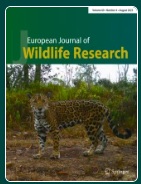Predator-friendly ranching, use of electric fences, and creole cattle in the Colombian savannas
Carlos Valderrama Vasquez, Rafael Hoogesteijn, Esteban Payán, Howard Quigley, Almira Hoogesteijn

Eur J Wildl Res 70, 1 (2024).
https://doi.org/10.1007/s10344-023-01754-3
Abstract
Livestock ranching overlaps extensively with jaguar and puma distribution in the Casanare Department of east-central Colombia. Conservation programs prioritize large carnivores in the region. Ranchers retaliate by killing them in response to economic losses or fear related to their presence. Reducing retaliatory hunting is a top priority in the conservation of feline species. Predation mitigation methods (PMMs) are necessary to reduce depredation and increase tolerance for large felines. In a prospective cohort study, 16 ranches between 2017 and 2019 used electric fences (n = 14) and introduced creole cattle (n = 2) as PMMs. There was a significant difference in the risk and odds ratios between the control and treatment groups. Livestock depredation was 14.78 times higher outside PMM areas (OR, 14.78; RR, 0.069; p < 0.001) than inside such areas. The losses caused by depredation were much higher than the investments made in PMMs.